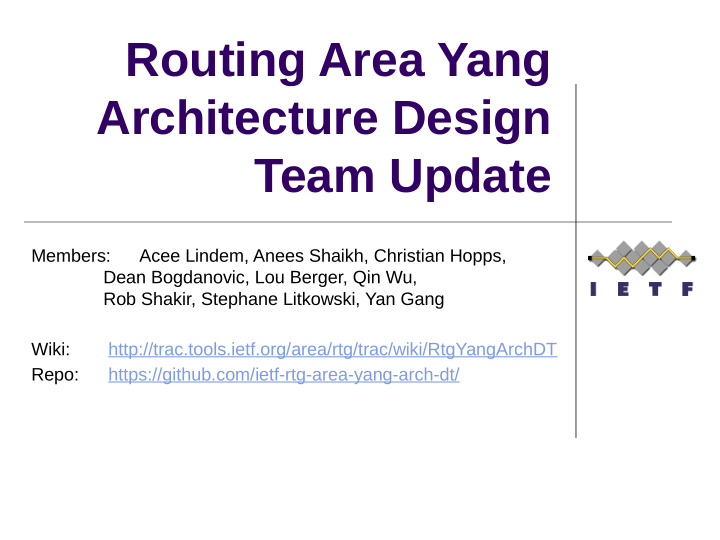



Routing Area Yang Architecture Design Team Update Members: Acee Lindem, Anees Shaikh, Christian Hopps, Dean Bogdanovic, Lou Berger, Qin Wu, Rob Shakir, Stephane Litkowski, Yan Gang Wiki: http://trac.tools.ietf.org/area/rtg/trac/wiki/RtgYangArchDT Repo: https://github.com/ietf-rtg-area-yang-arch-dt/
High Level Status DT identified four “work” topics: 1. YANG Device Model Structure Discussion Focus 2. YANG Relationship of Config and DT not recommending a specific solution Operational State (and intended) – Requirements generally accepted by NetMod 3. YANG support for reusable objects (containers) that are augmentable – like grouping only augmentable 4. Standard solution to the YANG versioning problem that is compatible with the RFC process and some degree of agility IETF 94 2
Network Device YANG Organizational Model draft-rtgyangdt-rtgwg-device-model-01 Authors: Acee Lindem, Christian Hopps, Dean Bogdanovic, Lou Berger (Ed.) Contributors: Anees Shaikh, Kevin D'Souza, Luyuan Fang, Qin Wu, Rob Shakir, Stephane Litkowski, Yan Gang Repo: https://github.com/ietf-rtg-area-yang-arch-dt/meta-model/
Topics Changes since -00 Open issues Next steps IETF 94 4
Changes: /device Top level /device was overly contentious Dropped ● No top level container subsuming entire device ● Interfaces now at top ● Still have representation of logical partitions module: network-device +--rw info | +--rw device-type? enumeration +--rw hardware +--rw qos +--rw logical-network-elements | ... augment /if:interfaces/if:interface: ... IETF 94 5
Logical Network Elements Network Device (Physical or Virtual) Logical Network Logical Network Device Element Element view Net Net Net Net Net Net Inst ance Inst ance Inst ance Inst ance Inst ance Inst ance Interfaces Interfaces Separate management sub-domains – Sub-domains can be managed independently and by a top level manager (device-view=true) Differs from multiple virtual devices and VMs – Where top level management of subdomains not supported IETF 94 6
Network Instances Network Device (Physical or Virtual) Logical Network Logical Network Element Element Net Net Net Net Net Net Inst ance Inst ance Inst ance Inst ance Inst ance Inst ance Interfaces Interfaces Separate routing / switching domains Can represent of an RFC 4364 VRF or a Layer 2 Virtual Switch Instance (VSI) or a bridge/router (i.e., both) General virtualized instance implying a separate L2, L3, or L2/L3 context. – For L3, this implies a unique IPv4/IPv6 address space. IETF 94 7
Changes: Interface Augmentations Provides linkage of interfaces to: Logical Network Elements – For e.g., physical interfaces – References provided by uint8 value Networking Instances – For e.g., logical interfaces on a physical interface – References provided by name string Leafref may be a better choice for references augment /if:interfaces/if:interface: +--rw bind-network-element-id? uint8 augment /if:interfaces/if:interface: +--rw bind-networking-instance-name? string augment /if:interfaces/if:interface/ip:ipv4: +--rw bind-networking-instance-name? string augment /if:interfaces/if:interface/ip:ipv6: +--rw bind-networking-instance-name? string IETF 94 8
Changes: Identities Identities for classes of protocols/services rather than attempting to list them all – Impacts: oam-protocols, control-plane-protocols, networking-services For example, control-plane-protocols: module: network-device +--rw logical-network-elements +--rw networking-instances +--rw networking-instance* […-name] +--rw control-plane-protocols +--rw control-plane-protocol* [type] +--rw type identityref +--rw policy Example types = bgp, is-is, ospf, rsvp, segment- routing, ldp, pim, igmp, mld, static-routes IETF 94 9
Open issues Main issue is representation of Logical Network Elements – Current approach is formal hierarchy that future models augment Alternatives are possible, e.g.: – Follow the Interface precedent with lists and references to LNE/NI in all models – Local mount based on draft-clemm-netmod-mount ● With client directed mounts, and new data (sub) store on mount – Tools-Based approach? . Working this off line with DT and mount authors – DT open to discussing other alternatives IETF 94 10
Organizational Model Impact Provides a predictable context for routing/router, bridging/bridge related configuration information Ensures support for wide range of possible implementations – With and without logical partitions (LNEs) – With and without VRF/VSI Beneficial for emerging models – LNEs and NIs need not be addressed per model Beneficial for operational use – Straightforward to delineate / reference per LNE/NI information IETF 94 11
Impact on ietf-routing Need to align draft-ietf-netmod-routing-cfg with draft Notably – No LNEs – Routing vs network instances ● No L2 / VSI allowed Interface references are to routing instances – No Ipv4 vs v6 mapping of interfaces to instance Leafrefs not strings used for YANG pointers – Minor issue, but this may be something to change in meta-model IETF 94 12
Design Team Future Plans Continue work on organizational model draft – Agree on solution to LNEs – Align with opstate solution once available Better coordination with OpenConfig including draft- openconfig-rtgwg-network-instance-00. Dove-tail with draft-ietf-netmod-routing-cfg Agree on when organization model draft should become a RTGWG draft See if there are other areas of concern for RTG area IETF 94 13
Reminder: Current DT Topics DT current topic list: 1. YANG Device Model Structure 2. YANG Relationship of Config and DT not recommending a specific solution Operational State (and intended) – Requirements generally accepted by NetMod 3. YANG support for reusable objects (containers) that are augmentable – like grouping only augmentable 4. Standard solution to the YANG versioning problem that is compatible with the RFC process and some degree of agility IETF 94 14
Recommend
More recommend